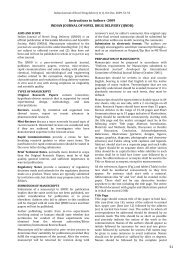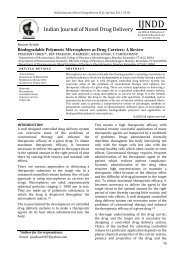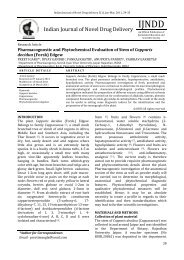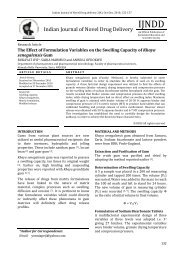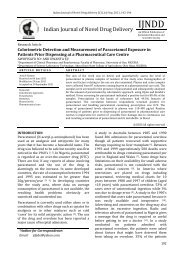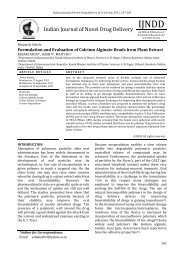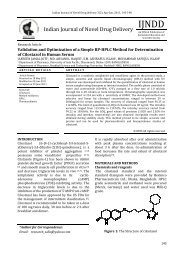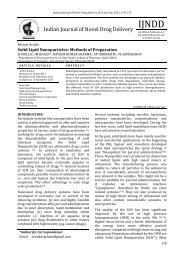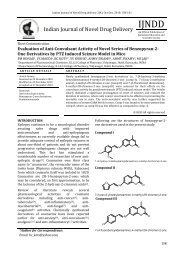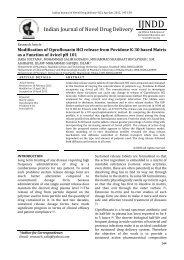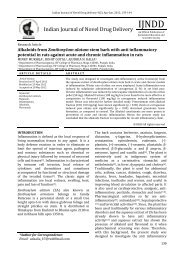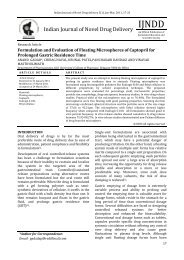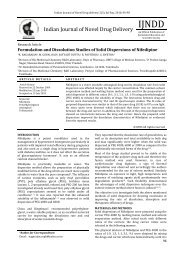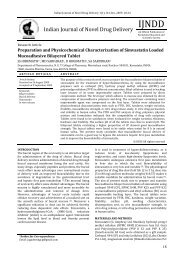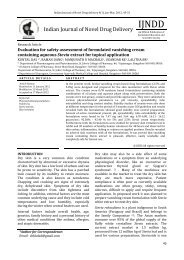Investigation of the Anti-Ulcer Activity of Chloroform Leaf Extract of ...
Investigation of the Anti-Ulcer Activity of Chloroform Leaf Extract of ...
Investigation of the Anti-Ulcer Activity of Chloroform Leaf Extract of ...
You also want an ePaper? Increase the reach of your titles
YUMPU automatically turns print PDFs into web optimized ePapers that Google loves.
Nwachukwu C. Daniel et al / Indian Journal <strong>of</strong> Novel Drug Delivery 4(1), Jan-Mar, 2012, 52-56<br />
Omeprazole is a proton pump inhibitor which<br />
forms a covalent disulphide bond with H+- K+<br />
ATPase (proton pump) and irreversibly<br />
inactivates <strong>the</strong> enzyme, thus blocking <strong>the</strong> final<br />
common pathway for acid secretion [35].<br />
Omeprazole also has anti-secretory and antiulcer<br />
effects [3] .<br />
Chlor<strong>of</strong>orm leaf extract <strong>of</strong> Aspilia Africana<br />
demonstrated gastroprotective activity against<br />
ulcer induced by aspirin in a dose-dependent<br />
manner; <strong>the</strong> higher dose <strong>of</strong> <strong>the</strong> extract<br />
(500mg/Kg) showed similar potency as<br />
omeprazole. The protection effect <strong>of</strong> <strong>the</strong> extract<br />
may be due its high content <strong>of</strong> flavonoids,<br />
alkaloids and saponins, phytochemicals that have<br />
demonstrated strong antioxidant properties [36] .<br />
Flavonoids are potent water soluble antioxidants<br />
and free radical scavengers which prevent<br />
oxidative cell damage and ulceration [36-38].<br />
Flavonoids also prevent gastric mucosal lesion<br />
and was identified as <strong>the</strong> most important plant<br />
constituents associated with anti-ulcer activity<br />
[39]. Flavonoids also possess anti-inflammatory<br />
activity [37] . Thus, <strong>the</strong> presence <strong>of</strong> large amount <strong>of</strong><br />
flavonoids in Aspilia Africana may justify its use<br />
in folk medicine for <strong>the</strong> treatment <strong>of</strong> ulcers,<br />
wounds and burns. Flavonoids, Saponins and<br />
tannins were reported to possess antiulcerogenic<br />
and anti-gastric activity [40, 41].<br />
Therefore, <strong>the</strong> presence <strong>of</strong> <strong>the</strong>se <strong>of</strong> <strong>the</strong>se<br />
compounds in <strong>the</strong> extract may be responsible for<br />
<strong>the</strong> observed anti-ulcer activity.<br />
CONCLUSION<br />
The leaf extract <strong>of</strong> Aspilia Africana demonstrated<br />
considerable anti-ulcer activity comparable to<br />
that <strong>of</strong> omeprazole in aspirin induced ulceration<br />
in rats. This action may be due to its<br />
phytochemical constituents especially<br />
flavonoids.<br />
REFERENCES<br />
[1] Adreoli T, Chan PD, Cowell JC, Gilbert DM,<br />
Green G, Johnson M. et al. Management <strong>of</strong><br />
patients with Gastric and Duodenal<br />
disorders In Brunner and Suddarth’s<br />
Textbook <strong>of</strong> Medical Nursing. 11th edition,<br />
Elsevier, Philaldephia, USA. pp 1203-1279;<br />
2008.<br />
[2] Ojewole EB. Peptic ulcer disease. In<br />
Therapeutic Basis <strong>of</strong> clinical pharmacy in<br />
<strong>the</strong> tropics. 3rd edition, SNAAP press,<br />
Enugu, Nigeria. pp 541-564; 2004.<br />
[3] Del Valle J, Cheg W, Scherman J. Acid Peptic<br />
Disorder in Textbook <strong>of</strong> gastroenteroloy.<br />
4th edition,Philaldephia, Lippincott<br />
William and Wilkins pp: 1321-1376; 2003.<br />
[4] Berandi RR, Welage S. Peptic <strong>Ulcer</strong> Disease<br />
In Pharmaco<strong>the</strong>rapy: A pathophysiologic<br />
approach. 6th edition McGraw-Hill pp: 629-<br />
648; 2005.<br />
[5] Suerbaum S, Michetti P. Helicobacter<br />
pylori infection. New English Journal <strong>of</strong><br />
Medicine 2002; 347: 1175-1186.<br />
[6] Chan FK, Leung WK. Peptic ulcer disease.<br />
Lancet 2002; 360: 933-939<br />
[7] Ojewole EB. Peptic ulcer disease In:<br />
Therapeutic basis <strong>of</strong> clinical pharmacy in<br />
<strong>the</strong> tropic. 2nd edition, optimal publishers<br />
Enugu, Nigeria. Pp 401-437; 1996.<br />
[8] Watkins G. Geographical aspects <strong>of</strong> peptic<br />
ulcer. Modern trends in Gastroenterology,<br />
third edition by W.L. Card Butterworths,<br />
London; 1961.<br />
[9] Dogra JR. Studies on peptic ulcer in South<br />
India, part I: Introduction and Clinical<br />
study <strong>of</strong> 258 cases. Indian JL Med. Res.<br />
1940; 28:145.<br />
[10] Hadey GG. A study <strong>of</strong> peptic ulcer as found<br />
in South India: In proceedings <strong>of</strong> <strong>the</strong> group<br />
discussion on peptic ulcer, p 31, I.C.M.R.<br />
Publication, New Delhi, India; 1959.<br />
[11] Burton GW, Joyce D, Ingolk KU. Is vitamin<br />
E <strong>the</strong> only lipid soluble chain having<br />
antioxidant activity in human blood,<br />
plasma and erythrocyte? Archives <strong>of</strong><br />
Biochemistry and Biophsiology. 1993; 222:<br />
228-232.<br />
[12] Momin A. Role <strong>of</strong> indigenous medicine in<br />
primary health care. 1st International<br />
Seminar on Unani Medicine, New Delhi,<br />
India. 1987; p 54.<br />
[13] Okwu DE, Ekeke O. Phytochemical<br />
Screening and Mineral Composition <strong>of</strong><br />
Chewing Sticks in South eastern Nigeria.<br />
Global Journal <strong>of</strong> Pure and Applied Sciences<br />
2003; 9: 235-238.<br />
[14] Eweka AO. Histological Studies <strong>of</strong> <strong>the</strong><br />
effect <strong>of</strong> Oral administration <strong>of</strong> Aspilia<br />
africana (Asteraceae) leaf extract on<br />
Ovaries <strong>of</strong> female Wistar rats. African<br />
Journal <strong>of</strong> Traditional Complementary and<br />
Alternative Medicine. 2009; 6(1): 57-61.<br />
[15] Singha SC. Medicinal Plants <strong>of</strong> Nigeria.<br />
National Press, Lagos pp: 24-30; 1965.<br />
[16] Burkill HM. The useful plants <strong>of</strong> West<br />
Africa. African Royal Botanical Garden<br />
1985; 1: 446-447.<br />
[17] Okwu DE, Josiah C. Evaluation <strong>of</strong> <strong>the</strong><br />
chemical composition <strong>of</strong> two Nigerian<br />
55



